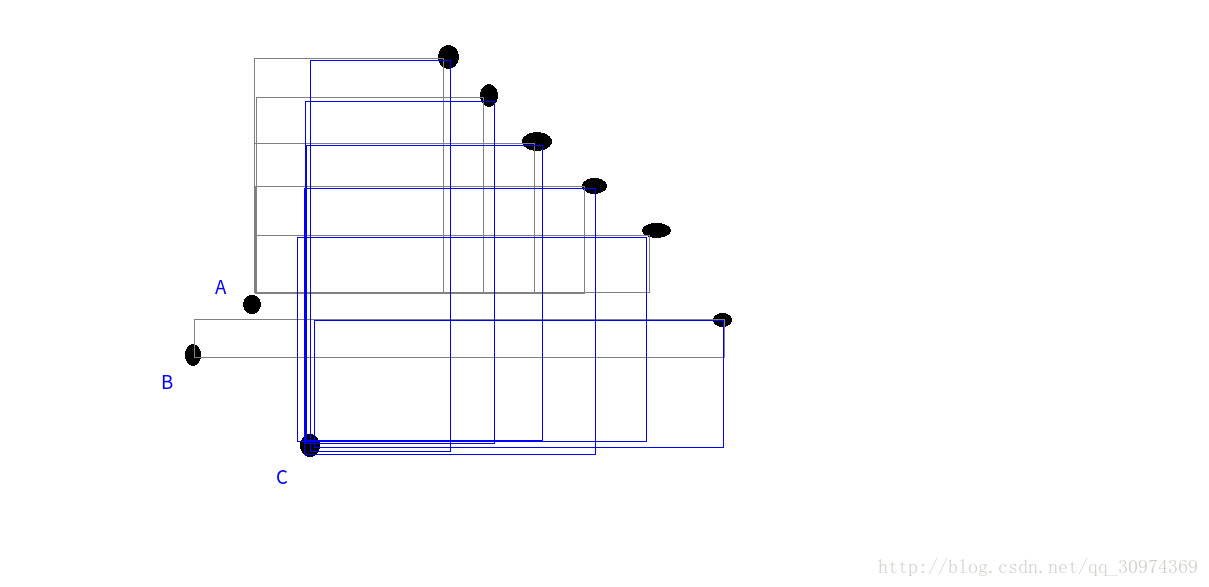[Hydro BZOJ](https://hydro.org.cn/d/bzoj/p/P4237) 这是我新发现的一个比 darkBZOJ 不知道快到哪里去的OJ,就是它的题面还要靠人工一点点修正。真是一个伟大的目标 ## Sol 有一个月没更博了... 首先暴力的搞法就是枚举每一个左下角,然后暴力看哪一些点可以贡献成为右上角 现在主要的问题在于确定右上角,那么来看看右上角都有哪些特点。 我们先设我们现在处理的左下角 $A$ 点在 $(x_1, y_1)$ 的位置 首先,假如有一列候选的右上角的点,它们的恒左边相同,此时只有最下面的点可以成为右上角。这一点比较显然。 现在考虑其他的点对 $A$ 点的影响,借 yyb 的图用一下  此时对于 $C$ 点来说,没有受到 $A$,$B$ 两点的贡献限制。但是很显然 $B$ 受到了 $A$ 的限制。可以看出来,一个点的横坐标如果比另外一个点的要大,它就会影响那些点的贡献。 那么应该用cdq分治搞的想法应该就出来了。首先肯定要对 $x$ 轴坐标排序。然后按照 $y$ 轴坐标从大到小的顺序一次加入处理。对左右两边同时开单调栈,保证 $x$ 轴坐标的单调性。右边的从小到大,左边的从大到小,那么这样就保证了每一个左侧点对在单调栈中前面一个元素影响。也就是说,假如上面那个图不这样做,假如 A B C对于当前的区间都在同一侧, B 可能就会对 A C两个点计算重复的部分。这样用单调栈维护顺序就不会了。 关于每次选入的点,单调栈上二分是常见操作了吧 ## Code ```cpp #include <bits/stdc++.h> using namespace std; typedef long long LL; const int SIZE = 5e5 + 5; int n; LL ans; int stal[SIZE], star[SIZE]; struct node { int x, y; bool operator< (const node &a) const { return x < a.x; } } a[SIZE]; namespace GTR { const int bufl = 1 << 15; char buf[bufl], *s = buf, *t = buf; inline int fetch() { if (s == t) { t = (s = buf) + fread(buf, 1, bufl, stdin); if (s == t) return EOF; } return *s++; } inline int read() { int a = 0, b = 1, c = fetch(); while (c < 48 || c > 57) b ^= c == '-', c = fetch(); while (c >= 48 && c <= 57) a = (a << 1) + (a << 3) + c - 48, c = fetch(); return b ? a : -a; } } using GTR::read; int cmp(node a, node b) { return a.y > b.y; } void cdq(int l, int r) { if (l == r) return; int mid = (l + r) >> 1; cdq(l, mid), cdq(mid + 1, r); std::sort(a + l, a + mid + 1, cmp); std::sort(a + mid + 1, a + r + 1, cmp); int ql = 0, qr = mid + 1, top = 0; for (int i = l; i <= mid; ++ i) { while (qr <= r && a[qr].y > a[i].y) { while (top && a[star[top]].x > a[qr].x) -- top; star[++ top] = qr ++; } while (ql && a[stal[ql]].x < a[i].x) -- ql; stal[++ ql] = i; if (ql == 1) ans += top; else { int xl = 1, xr = top, res = top + 1; while (xl <= xr) { int mi = (xl + xr) >> 1; if (a[star[mi]].y > a[stal[ql - 1]].y) xl = mi + 1; else res = mi, xr = mi - 1; } ans += top - res + 1; } } } int main() { n = read(); for (int i = 1; i <= n; ++ i) a[i].x = read(), a[i].y = read(); std::sort(a + 1, a + n + 1); cdq(1, n); printf("%lld\n", ans); return 0; } ``` Loading... [Hydro BZOJ](https://hydro.org.cn/d/bzoj/p/P4237) 这是我新发现的一个比 darkBZOJ 不知道快到哪里去的OJ,就是它的题面还要靠人工一点点修正。真是一个伟大的目标 ## Sol 有一个月没更博了... 首先暴力的搞法就是枚举每一个左下角,然后暴力看哪一些点可以贡献成为右上角 现在主要的问题在于确定右上角,那么来看看右上角都有哪些特点。 我们先设我们现在处理的左下角 $A$ 点在 $(x_1, y_1)$ 的位置 首先,假如有一列候选的右上角的点,它们的恒左边相同,此时只有最下面的点可以成为右上角。这一点比较显然。 现在考虑其他的点对 $A$ 点的影响,借 yyb 的图用一下  此时对于 $C$ 点来说,没有受到 $A$,$B$ 两点的贡献限制。但是很显然 $B$ 受到了 $A$ 的限制。可以看出来,一个点的横坐标如果比另外一个点的要大,它就会影响那些点的贡献。 那么应该用cdq分治搞的想法应该就出来了。首先肯定要对 $x$ 轴坐标排序。然后按照 $y$ 轴坐标从大到小的顺序一次加入处理。对左右两边同时开单调栈,保证 $x$ 轴坐标的单调性。右边的从小到大,左边的从大到小,那么这样就保证了每一个左侧点对在单调栈中前面一个元素影响。也就是说,假如上面那个图不这样做,假如 A B C对于当前的区间都在同一侧, B 可能就会对 A C两个点计算重复的部分。这样用单调栈维护顺序就不会了。 关于每次选入的点,单调栈上二分是常见操作了吧 ## Code ```cpp #include <bits/stdc++.h> using namespace std; typedef long long LL; const int SIZE = 5e5 + 5; int n; LL ans; int stal[SIZE], star[SIZE]; struct node { int x, y; bool operator< (const node &a) const { return x < a.x; } } a[SIZE]; namespace GTR { const int bufl = 1 << 15; char buf[bufl], *s = buf, *t = buf; inline int fetch() { if (s == t) { t = (s = buf) + fread(buf, 1, bufl, stdin); if (s == t) return EOF; } return *s++; } inline int read() { int a = 0, b = 1, c = fetch(); while (c < 48 || c > 57) b ^= c == '-', c = fetch(); while (c >= 48 && c <= 57) a = (a << 1) + (a << 3) + c - 48, c = fetch(); return b ? a : -a; } } using GTR::read; int cmp(node a, node b) { return a.y > b.y; } void cdq(int l, int r) { if (l == r) return; int mid = (l + r) >> 1; cdq(l, mid), cdq(mid + 1, r); std::sort(a + l, a + mid + 1, cmp); std::sort(a + mid + 1, a + r + 1, cmp); int ql = 0, qr = mid + 1, top = 0; for (int i = l; i <= mid; ++ i) { while (qr <= r && a[qr].y > a[i].y) { while (top && a[star[top]].x > a[qr].x) -- top; star[++ top] = qr ++; } while (ql && a[stal[ql]].x < a[i].x) -- ql; stal[++ ql] = i; if (ql == 1) ans += top; else { int xl = 1, xr = top, res = top + 1; while (xl <= xr) { int mi = (xl + xr) >> 1; if (a[star[mi]].y > a[stal[ql - 1]].y) xl = mi + 1; else res = mi, xr = mi - 1; } ans += top - res + 1; } } } int main() { n = read(); for (int i = 1; i <= n; ++ i) a[i].x = read(), a[i].y = read(); std::sort(a + 1, a + n + 1); cdq(1, n); printf("%lld\n", ans); return 0; } ``` 最后修改:2021 年 08 月 20 日 © 允许规范转载 打赏 赞赏作者 支付宝微信 赞 如果觉得我的文章对你有用,请随意赞赏